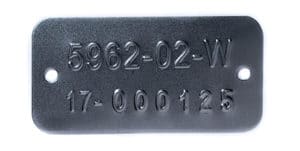Nearly every industrial workplace involves using tools to get the job done. Manufacturing plants need tools for production and assembly, construction sites need tools for building, etc. Metal tool tags and labels allow for organizations to identify, track, and monitor their tooling.
Many organizations invest a ton of resources into acquiring and maintaining their tools and similar equipment. Industrial strength tools such as specialized machinery are very expensive, and often require additional training and overhead.
This can be as simple as a serialized tag placed on each tool, or as complex as barcodes added to equipment to include it in asset management software.
Industrial tools are also a target for theft due to their high resale value and utility. Diligently marking each tool with a custom “property of (company)” may seem like a simple solution, but it is highly effective in deterring theft.
Durability
As with all items manufactured for industrial use, durability is one of the first things that come to mind. Industrial type environments include exposure to chemicals, wear and tear, and just about everything else you don’t want your tools exposed to. That’s why industrial parts and tools need to be resilient.
How durable are metal tags? That entirely depends on the material they’re produced from, and the process used for marking information on the tags. For example, a plastic decal with printed ink is not nearly as durable as a stamped aluminum nameplate.
Materials
Selecting a material for your identification nameplates is more than just an aesthetic decision. Some applications require specific materials.
Popular material options for tool tags include:
- Stainless Steel
- Aluminum
- Anodized Aluminum
- Cold Rolled Steel
- Brass
Process Options
Embossing
If you invest your time and money into marking your tools with identification tags, you expect to get a ton of use out of them. With embossing, this is never a concern. In some cases, the embossed tags will last longer than the tool it is attached to.
This process utilizes a die set to mark your information directly into the metal with a raised impression. These characters are very easy to read (even when covered by paint or dirt). In addition, the design is incredible durable since it is formed from the metal material itself. A little bit of rain or wear and tear is not going to make your design scrape off. These nameplates typically exceed 20 years even in the harshest industrial environments.
Photo Anodization
One of the most popular marking methods due to its all-around strengths, photo anodization is a highly versatile process.
This process embeds your design beneath layers of anodized aluminum material. Providing a smooth to the touch finish, that is highly durable and legible.
In addition to basic text and number designs, photo anodized nameplates can include logos for company branding, and barcodes for asset traceability.
Adhering a barcode tag to your tool instantly turns it into a traceable asset which can be managed via computer software. This not only prevents theft, but allows for information to be shared regarding tool location, maintenance, and any other relevant info.
Another major benefit to photo anodizing is its 20+ year outdoor durability. The anodized aluminum material and marking are resilient enough to withstand weather, wear, and chemical exposure.
These tags can include an adhesive backing for quick and easy attachment. This is also great for tool tagging as it doesn’t require any physical modifications to the tool (i.e. installing screws or bolts)
Decals/Labels
If you are looking for a low cost alternative to metal id tags, custom decals are a great solution. These printed labels feature full color designs, including barcodes or custom logos.
In addition, they can be produced in nearly any size or shape necessary, and are significantly more flexible than their metal counterparts. This means custom labels can accommodate nearly any tool or piece of equipment necessary.
While these labels may be a more cost effective solution, keep in mind that they are not the most durable type of marker. Since the ink is printed on the surface of the material, it is fairly easy for it to get scratched or worn off. Laminates can be added to provide some additional protection.
Decals and labels are best suited for more mild environments, or locations which won’t see much exposure to tough conditions.
Direct Marking
Sometimes applying a tag or nameplate to a tool is impractical or just not preferred. Small tools especially can be hard to label with a metal nameplate. In these instances, marking items directly may be a better alternative.
Dot peen marking is one of the most common methods of marking direct onto equipment. This involves a machine which uses a small stylus to repeatedly strike the surface, creating small dot-like patterns. This is frequently used for marking tools and components that are too small to label with traditional identification labels.
The dot pin marking process allows for basic designs, and even data matrix codes if necessary. As the impression is not very deep, nor does it work on every material, the applications for this process can be limited. However, applications which it is suitable for often use it to great success.
Wrap Up
Every industrial type organization relies on their tools to keep their operation running smoothly. Effective labeling of tools allows for quick and easy identification, traceability, and theft prevention. From tracking down the location of specific tools to labeling information, there are endless uses for metal tool tags.

